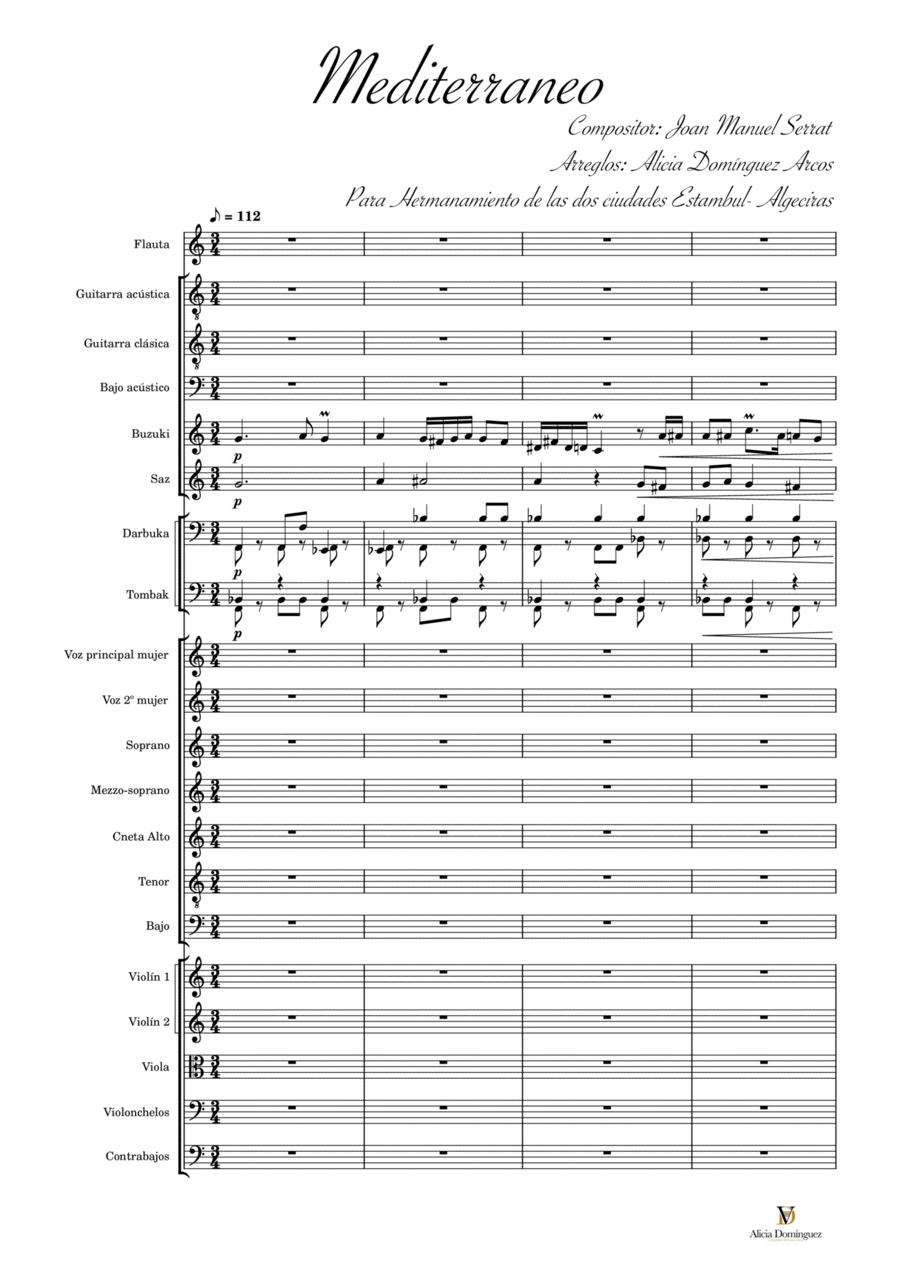Level 2 - Digital Download SKU: A0.1372693 By Alicia DomÃnguez Arcos Sonay. By Joan Manuel Serrat. Arranged by Alicia DomÃnguez Arcos. Film/TV,Multicultural,Pop,Praise & Worship,Singer/Songwriter,World. 30 pages. Alicia Dominguez #957004. Published by Alicia Dominguez (A0.1372693). In these 112 measures for the twinning of Istanbul-Algeciras I have wanted to incorporate concepts from both parties, with the respect that the composition of Don Joan Manuel Serrat deserves in which in 1970 he sang âMare Nostrumâ (Nostrum mare more correctly in Latin classic, being one of the popular anthems of Spain and therefore a cultural heritage. Therefore it can be used instrumentally or if required, there is a number in the score of which, although the guitar has a melody and one of the choral voices, with two guitars, or make two choral voices or join with your own melody, use both bowed string instruments and plucked strings, etc.Likewise, there are two voices, of which a single voice can use the phrasings of both one voice and the other, giving it its own personality.The tempo will be whatever the interpretation itself wants, much slower, without accelerating so much between the beginning and the moment of the song itself. I have incorporated some instruments into the arrangement as examples:Buzukibouzouki, like the sazturco and the Lebanese Buzuq, which belong to the same family of Buzuki instruments.And as percussion only percussion The Turkish Darbuka is a percussion musical instrument The Turkish Darbuka is a percussion musical instrument from Turkey. The Turkish Darbuka have a high range of low and high resonant tones that sound between the two registers; serious (Dum) and acute (Tek). The edge or lip allows for finger breaking techniques that are not possible in the Egyptian Darbuka.And the Tombak, also called Dombak Ozarb, is a chalice-shaped drum, traditionally built with a hollowed-out biker or walnut trunk covered with skin at one end.With the beginning and among the work itself I wanted to give place to the Bashraf (Turkish Pesrev and Persian Pishraw, which means Overture) and the Sama'i (Turkish Sam Semai) Instrumental genre that is used in the Turkish court and in Sufi music . They were introduced into the Arab world before the 19th century.And also give place in his forms to the Ottoman composer Ismail Hakkibei (1866-1927). Unite Serrat with Hakkibey with this Istanbul-Algeciras work.Although the Bashraf is always made up of four points, Khanat (Plural Dekhana) or Hanne in Turkish, which are always followed by a chorus (Taslim / Teslim), its structure being Khana 1+ Taslim, Khana 2, Khana 3+ Taslim, Khana 4 + Taslim.The fragments must be incorporated since the main base is the Mediterranean pop theme. For this reason, its original rhythm is the Defâhte (In Arabic, Faakhito Fahitah Turki. Being a 20/4 time signature subdivided into 5 sub-groups of 4/4 where the complete cycle coincides with the phrases of the theme. Without forgetting that in music Arabic with the oriental rhythm Lsaada Duyukde 8/8 making a cycle for each measure of 4/4, that is, cycles per phrase, if those written for Western reading in 4/4 with double durations and simplicity. Unit of time: quarter note , coincides in two phrases of 5 measures per staff for a better understanding of the form of the piece, also within a written Arabic version of the theme the unit of time is eighth note 8/8 in G, but it had to be incorporated into Mediterráneo and it is always It is more feasible to think of the human voice as being more limited than instrumentation such as flute, plucked leather instruments, and bowed string instruments.Instrumentation:FluteGuitar 1 (1st voice melody)Guitar 2 (2nd voice melody)Bass (accompaniment and chords)BuzukiSazDarbukaTombakVoice 1st2nd voiceSMATB Voices1st violin2nd violinViolaCellosDouble basses.
